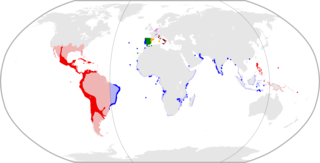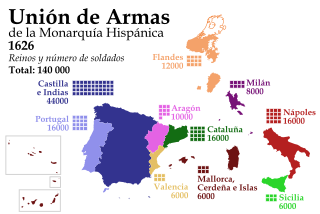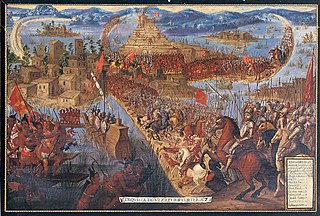
The overseas expansion under the Crown of Castile was initiated under the royal authority and first accomplished by the Spanish conquistadors. The Americas were incorporated into the Spanish Empire, with the exception of Brazil, Canada, the eastern United States and several other small countries in South America and The Caribbean. The crown created civil and religious structures to administer the region. The motivations for colonial expansion were trade and the spread of the Catholic faith through indigenous conversions.

The Viceroyalty of New Spain was an integral territorial entity of the Spanish Empire, established by Habsburg Spain during the Spanish colonization of the Americas. It covered a huge area that included territories in North America, South America, Asia and Oceania. It originated in 1521 after the fall of Mexico-Tenochtitlan, the main event of the Spanish conquest, which did not properly end until much later, as its territory continued to grow to the north. It was officially created on 8 March 1535 as a viceroyalty, the first of four viceroyalties Spain created in the Americas. Its first viceroy was Antonio de Mendoza y Pacheco, and the capital of the viceroyalty was Mexico City, established on the ancient Mexico-Tenochtitlan.

The Viceroyalty of Peru was a Spanish imperial provincial administrative district, created in 1542, that originally contained modern-day Peru and most of Spanish-ruled South America, governed from the capital of Lima. The Viceroyalty of Peru was one of the two Spanish Viceroyalties in the Americas from the sixteenth to the eighteenth centuries.

The Spanish Empire, historically known as the Hispanic Monarchy and as the Catholic Monarchy, was one of the largest empires in history. From the late 15th century to the early 19th, Spain controlled a huge overseas territory in the New World and the Asian archipelago of the Philippines, what they called "The Indies". It also included territories in Europe, Africa and Oceania. The Spanish Empire has been described as the first global empire in history, a description also given to the Portuguese Empire. It was the world's most powerful empire during the 16th and first half of the 17th centuries, reaching its maximum extension in the 18th century. The Spanish Empire was the first empire to be called "the empire on which the sun never sets".

The Catholic Monarchs is the joint title used in history for Queen Isabella I of Castile and King Ferdinand II of Aragon. They were both from the House of Trastámara and were second cousins, being both descended from John I of Castile; on marriage they were given a papal dispensation to deal with consanguinity by Sixtus IV. They married on October 19, 1469, in the city of Valladolid; Isabella was eighteen years old and Ferdinand a year younger. It is generally accepted by most scholars that the unification of Spain can essentially be traced back to the marriage of Ferdinand and Isabella. Some newer historical opinions propose that under their rule, what later became Spain was still a union of two crowns rather than a unitary state, as to a large degree Castile and Aragon remained separate kingdoms, with most of their own separate institutions, for decades to come. The court of Ferdinand and Isabella was constantly on the move, in order to bolster local support for the crown from local feudal lords.
Alcalde, or Alcalde ordinario, is the traditional Spanish municipal magistrate, who had both judicial and administrative functions. An alcalde was, in the absence of a corregidor, the presiding officer of the Castilian cabildo and judge of first instance of a town. Alcaldes were elected annually, without the right to reelection for two or three years, by the regidores of the municipal council. The office of the alcalde was signified by a staff of office, which they were to take with them when doing their business. A woman who holds the office is termed an Alcaldesa.

The suppression of the Jesuits in the Portuguese Empire (1759), France (1764), the Two Sicilies, Malta, Parma, the Spanish Empire (1767) and Austria and Hungary (1782) is a complex topic. Analysis of the reasons is complicated by the political maneuvering in each country which was not carried on in the open but has left some trail of evidence. The papacy reluctantly went along with the demands of the various Catholic kingdoms involved, and advanced no theological reason for the suppression.

The Casa de Contratación or Casa de la Contratación de las Indias was established by the Crown of Castile, in 1503 in the port of Seville as a crown agency for the Spanish Empire. It functioned until 1790, when it was abolished in a government reorganization. Before the establishment of the Council of the Indies in 1524, the Casa de Contratación had broad powers over overseas matters, especially financial matters concerning trade and legal disputes arising from it. It also was responsible for the licensing of emigrants, training of pilots, creation of maps and charters, probate of estates of Spaniards dying overseas. Its official name was La Casa y Audiencia de Indias.
The Real Audiencia, or simply Audiencia, was an appellate court in Spain and its empire. The name of the institution literally translates as Royal Audience. The additional designation chancillería was applied to the appellate courts in early modern Spain. Each audiencia had oidores.

The Council of the Indies; officially, the Royal and Supreme Council of the Indies, was the most important administrative organ of the Spanish Empire for the Americas and the Philippines. The crown held absolute power over the Indies and the Council of the Indies was the administrative and advisory body for those overseas realms. It was established in 1524 by Charles V to administer "the Indies," Spain's name for its territories. Such an administrative entity, on the conciliar model of the Council of Castile, was created following the Spanish conquest of the Aztec empire in 1521, which demonstrated the importance of the Americas. Originally an itinerary council that followed Charles V, it was subsequently established as an autonomous body with legislative, executive and judicial functions by Philip II of Spain and placed in Madrid in 1561. The Council of the Indies was abolished in 1812 by the Cádiz Cortes, briefly restored in 1814 by Ferdinand VII of Spain, and definitively abolished in 1834 by the regency, acting on behalf of the four-year-old Isabella II of Spain.

A colonial empire is a collective of territories, mostly overseas, settled by the population of a certain state and governed by that state.

The Council of Castile, known earlier as the Royal Council, was a ruling body and key part of the domestic government of the Crown of Castile, second only to the monarch himself. It was established under Queen Isabella I in 1480 as the chief body dealing with administrative and judicial matters of the realm. With the 1516 ascension of King Charles I to the throne of both Castile and Aragon, the Royal Council came to be known as the Council of Castile because Charles was king of many dominions other than Castile, while the Council retained responsibility only over Castile.

The New Kingdom of Granada, or Kingdom of the New Granada, was the name given to a group of 16th-century Spanish colonial provinces in northern South America governed by the president of the Audiencia of Santa Fe, an area corresponding mainly to modern-day Colombia, Panama and Venezuela. The conquistadors originally organized it as a captaincy general within the Viceroyalty of Peru. The crown established the audiencia in 1549. Ultimately the kingdom became part of the Viceroyalty of New Granada first in 1717 and permanently in 1739. After several attempts to set up independent states in the 1810s, the kingdom and the viceroyalty ceased to exist altogether in 1819 with the establishment of Gran Colombia.
Clarence Henry Haring was an important historian of Latin America and a pioneer in initiating the study of Latin American colonial institutions among scholars in the United States.
A corregidor was a local administrative and judicial official in Spain and in its overseas empire. They were the representatives of the royal jurisdiction over a town and its district.

Ferdinand II, called the Catholic, was King of Aragon from 1479 until his death. His marriage in 1469 to Isabella, the future queen of Castile, was the marital and political "cornerstone in the foundation of the Spanish monarchy." As a consequence of his marriage to Isabella I, he was de jure uxoris King of Castile as Ferdinand V from 1474 until her death in 1504. At Isabella's death the crown of Castile passed to their daughter Joanna, by the terms of their prenuptial agreement and her last will and testament. Following the death of Joanna's husband Philip I of Spain, and her alleged mental illness, Ferdinand was recognized as regent of Castile from 1508 until his own death. In 1504, after a war with France, he became King of Naples as Ferdinand III, reuniting Naples with Sicily permanently and for the first time since 1458. In 1512, he became King of Navarre by conquest. In 1506 he married Germaine of Foix of France, but Ferdinand's only son and child of that marriage died soon after birth; had the child survived, the personal union of the crowns of Aragon and Castile would have ceased.

There are 13 monarchies in the Americas. Each is a constitutional monarchy, where in the sovereign inherits his or her office, usually keeping it until death or abdication, and is bound by laws and customs in the exercise of their powers. Ten of these monarchies are independent states, and equally share Queen Elizabeth II, who resides primarily in the United Kingdom, as their respective sovereign, making them part of a global grouping known as the Commonwealth realms, while the remaining three are dependencies of European monarchies. As such, none of the monarchies in the Americas have a permanently resident monarch.
The royal fifth is an old royal tax that reserves to the monarch 20% of all precious metals and other commodities acquired by his subjects as war loot, found as treasure or extracted by mining. The 'royal fifth' was instituted in Medieval Muslim states, Christian Iberian kingdoms and their overseas colonial empires during the age of exploration.

The Union of Arms was a political proposal, put forward by Gaspar de Guzmán, Count-Duke of Olivares for greater military co-operation between the constituent parts of the composite monarchy ruled by Philip IV of Spain.

The historiography of Spanish America has a long history. It dates back to the early sixteenth century with multiple competing accounts of the conquest, Spaniards’ eighteenth-century attempts to discover how to reverse the decline of its empire, and Latin American-born Spaniards' (creoles') search for an identity other than Spanish, and the creation of creole patriotism. Following independence in some parts of Spanish America, some politically-engaged citizens of the new sovereign nations sought to shape national identity. In the nineteenth and early twentieth centuries, non-Spanish American historians began writing chronicles important events, such as the conquests of Mexico and Peru, dispassionate histories of the Spanish imperial project after its almost complete demise in the hemisphere, and histories of the southwest borderlands, areas of the United States that had previously been part of the Spanish Empire, led by Herbert Eugene Bolton. At the turn of the twentieth century, scholarly research on Spanish America saw the creation of college courses dealing with the region, the systematic training of professional historians in the field, and the founding of the first specialized journal, Hispanic American Historical Review. For most of the twentieth century, historians of colonial Spanish America read and were familiar with a large canon of work. With the expansion of the field in the late twentieth century, there has been the establishment of new subfields, the founding of new journals, and the proliferation of monographs, anthologies, and articles for increasingly specialized practitioners and readerships. The Conference on Latin American History, the organization of Latin American historians affiliated with the American Historical Association, awards a number of prizes for publications, with works on early Latin American history well represented.













